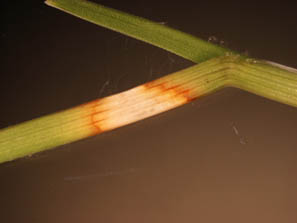Dollar Spot on Turf | |
|---|---|
| July 25, 2008 | |
|
Admittedly, turf diseases are not my favorite to diagnose. Most of the diagnosticians in the Midwest would agree. There are many noninfectious problems that can mimic turf diseases; and fruiting bodies and spores are often difficult to find. A recent turf sample at the University of Illinois Plant Clinic was infected with a fungal disease called dollar spot, which is a bit easier to confirm in the lab. Given environmental conditions, we may be seeing more of this disease. Dollar spot is a fungal disease. Originally Sclerotinia homoeocarpa was thought to be the cause of the disease. Now fungal species in the genera Mollerodiscus and Lanzia are associated with it. Some fungal strains grow best in cool temperatures, while other strains develop in warm temperatures. The disease may appear when temperatures are 60? to 90?F. Warm days, high humidity, and cool nights seem best for disease development. Dollar spot disease is named for the silver dollar–sized spots that appear in the lawn. The turf in these areas is straw colored. Spots may merge to form larger areas, but you should be able to see the spots as well. The image shows this disease in a home lawn.  If you look closely at an individual grass plant, you will see dollar spot lesions as bleached, hourglass spots that reach across the width of the blades. Often a reddish brown band is present at the edge of the lesion. The image shows a dollar spot lesion that was incubated in our lab. You can see the white mycelium of the fungus beginning to develop.  This disease may appear in well-kept lawns, as well as those that receive little attention. Often, it is found in areas with low nitrogen. It is also more common in areas of poor drainage. Evaluate the fertilization in the affected lawn and try to provide a balanced program. Water the lawn early in the day so that the turf dries more quickly. Evening watering increases disease pressures. Core-aerify the lawn in the spring and/or fall to reduce compaction and to reduce the thatch layer. Fungicides may be used when the disease first appears. Consult the Home, Yard, & Garden Pest Guide or the Commercial Landscape & Turfgrass Pest Management Handbook for options, should you decide to include fungicides in your management plan. For more information on this disease, consult Report on Plant Disease (RPD), no. 407, “Dollar Spot of Turfgrasses,” which can be found online at http://www.ag.uiuc.edu/%7Evista/abstracts/a407.html. | |
| Author: | Nancy Pataky |
